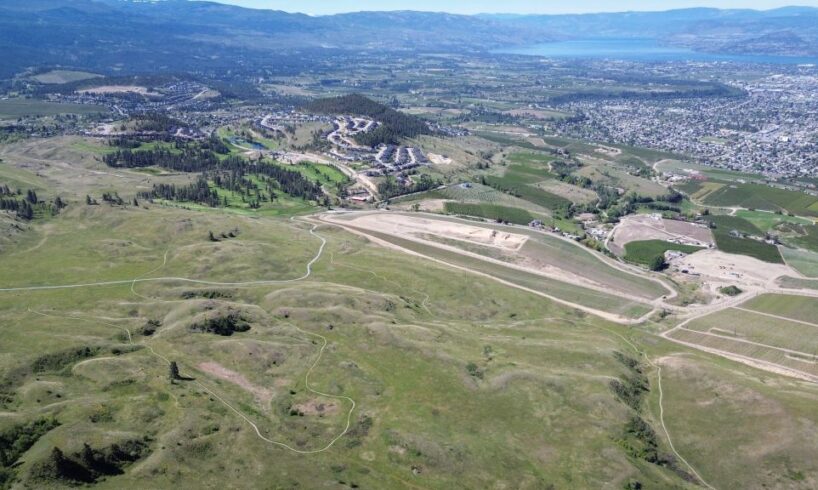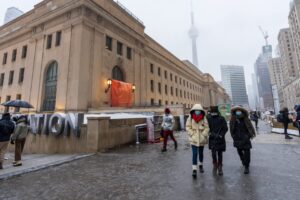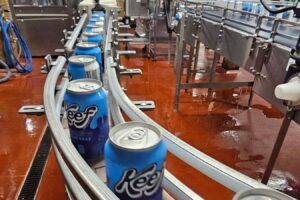
This story was produced in collaboration with IndigiNews. It is part of Habitat, a series from The Narwhal which looks at how communities are working to address the housing and climate change crises simultaneously.
A handful of small yellow butterflies flutter across the path as Scott Boswell, manager of the Okanagan Collaborative Conservation Program, walks through the grasslands on the eastern slopes of Kelowna, B.C. With each step, the crunch of gravel melds with the rhythmic chirps of hidden crickets.
More than a thousand plants and animals can be found in these rolling hills, he says. But many — from badgers to Lewis’s woodpeckers — are at risk of disappearing. Some have already been lost, their habitats eroded by the steady advance of urban and agricultural development.
“If we want to protect this low elevation ecosystem, this is the only place left in this part of the Okanagan,” he says.
Boswell pauses at the crest of a hill and looks out across Kelowna. The city stretches north and south along the shores of Okanagan Lake — kɬúsx̌nítkʷ in nsyilxcən, the language of the syilx people who have called these lands home since time immemorial — and east towards these remaining grasslands.
In less than 200 years, the city has transformed this landscape. The spacious homes and big backyards of suburban neighbourhoods, the vineyards that draw tourists for summer wine tastings, the airport and university all came at a cost. Wetlands were filled in, dry open forests were cut down, grasslands were scraped away.
sntsk’il’ntən-Black Mountain Regional Park protects a vital stretch of grasslands on Kelowna’s eastern slopes. sntsk’il’ntən, which means “place where flint is found” in nsyilxcən, is a sacred place for syilx people.
These grasslands support tens of thousands of species, from tiny bacteria in the soil and birds that stop over to refuel on long migrations.
Scott Boswell, the manager of the Okanagan Collaborative Conservation Program, is working to protect some of the last connected low-elevation ecosystems in this part of the Okanagan.
“These impacts are not only ecological — they represent a disruption of longstanding relations,” Westbank First Nation Chief Robert Louie explains in a statement. “For syilx people, land and water systems are understood as kin, meaning changes to the land are felt deeply within the community.”
Today, the remaining grasslands that stretch across the eastern slopes of Kelowna are one of the most endangered ecosystems in the country. At the same time, the city and surrounding communities are still growing. A 2023 housing assessment found Kelowna alone needs between 3,750 and 5,000 housing units to meet the needs of its current population — thousands more will be needed in the years to come.
Caught between a growing population and shrinking ecosystems, Kelowna reflects a challenge playing out across the country: how to build quickly without sacrificing nature and the relationships that depend on it.
Okanagan wildlife corridor aims to preserve remaining grasslands and make space for wildlife to roam
In the grasslands on the eastern slopes of Kelowna, Boswell gestures south towards Okanagan Mountain Provincial Park. “It’s got everything you can imagine in there — mountain goats, mountain sheep, rattlesnakes, everything — but it’s not big enough to maintain their populations over the long-term,” he says. “They need other big habitat patches to maintain their genetic diversity.”
He’s standing in sntsk’il’ntən-Black Mountain Regional Park, another vital stretch of grasslands and forests protected from development. Across the Okanagan there are other patches of habitat like this protected by regional or provincial parks. But more and more attention is being paid to the importance of protecting the connections between them — on Wednesday the federal and provincial governments announced $8.3 million to strengthen ecological corridors in B.C.
There are efforts underway to protect the Knox Mountain and Okanagan Mountain to k’nmalka corridors from development in recognition of the importance of connected ecosystems for wildlife. Map: Shawn Parkinson / The Narwhal
Boswell and the Okanagan Collaborative Conservation Program are pushing to protect a 65-kilometre-long, one-kilometre-wide wildlife corridor between Okanagan Mountain Provincial Park, south of Kelowna, and k’nmalka or Kalamalka Lake Provincial Park area to the north. The corridor, which runs along the sideslope between these two parks, spans grasslands, pockets of lush riparian ecosystems and ponderosa pine and Douglas fir forests — increasingly rare ecosystems, even more unique in this area because of the connections that allow wildlife to move relatively freely between them. Parts of this corridor, including sntsk’il’ntən, are already being conserved, but other areas remain vulnerable to urban and agricultural development.
Protecting the rest “is a really grand idea,” especially if it keeps the urban sprawl from creeping even farther upslope, says Dixon Terbasket, who until recently worked for the syilx Okanagan Nation Alliance as a wildlife technician. He was part of the advisory team that worked with the Okanagan Collaborative Conservation Program to create an action plan for protecting the corridor. Even at just one kilometre wide, the corridor is a chance to protect some of the remaining land where medicinal plants can still be found, where mule deer and elk feel safe enough to have their babies, where wildlife has room to move north and south relatively unencumbered, Terbasket says. It’s about “giving the animals a right to travel, a right to have their homes, designating spots where this is a no-go zone.”
Dixon Terbasket, a syilx Knowledge Keeper, worries about the impact of tremendous growth and development in Okanagan communities. “People need to really start thinking about the future of their grandkids, their great grandkids,” he says. Photo: Aaron Hemens / IndigiNews
Chief Louie underscores that this is not just about safeguarding ecosystems — it’s about honouring the deep, enduring connection to the land. “Protecting these movement pathways helps to uphold responsibilities to the land that have existed since time immemorial,” he says.
It “supports the integrity of the land as a living, interconnected system — not just for wildlife, but for the well-being of future generations.”
Politics a hurdle to long-term protection for Okanagan wildlife corridor
But even in sntsk’il’ntən, a protected area, the threat of encroaching development can still be felt. The houses that sit up on the hill just beyond the golf course. The new vineyard right at the edge of the park, where grasslands stood just a few years ago. “It’s a story as old as Kelowna, but it was heartbreaking to see it in real time,” wildlife biologist Adam Ford says.
“In these mountainous landscapes, from Canmore to Kelowna, the biodiversity is in the valley bottoms and the shallow slopes. That’s also where people want to build, so there’s always this tension,” he says. And biodiversity always seems to lose. At this point, all the remaining low-elevation grasslands left in the Okanagan need protection, says Ford, a Canada Research Chair in wildlife restoration ecology based at the University of British Columbia Okanagan.
The shape of the corridor, which runs north-south at roughly the same elevation, doesn’t necessarily match the pathway many animals take, Ford says. Elk and mule deer, for instance, often migrate from low elevations to high elevations depending on the season. “But that doesn’t mean it’s not helping to protect and support biodiversity,” he adds. “By and large, it’s good connectivity.”
Wildlife biologist Adam Ford says the mix of land uses — for housing, agriculture, nature — is one of the things he likes about Kelowna, but he warns the balance is off — and biodiversity always seems to lose.
sntsk’il’ntən itself may be protected, but housing developments, wineries and golf courses are built right to its edge.
He does question the width, however. Why one kilometre? The science isn’t clear on exactly how wide a wildlife crossing structure over a highway or a corridor through a fast-developing landscape should be to support biodiversity, Ford says. But research shows the impact of human activity can extend a few hundred metres, which could effectively whittle the benefits of a one-kilometre corridor down to 600 metres or so.
Boswell says a wider corridor would be better ecologically. But there are politics at play.
It would have been much more challenging to get buy-in from the various local and regional governments had the corridor been much wider, he says. It’s the same reason the corridor map skirts already-planned developments that will further encroach on the rich ecosystems of the eastern slopes. “We wanted to get it into the official community plans of local government and we recognized that if we put it 10-kilometres wide, it wouldn’t have happened,” Boswell says. But the hope is that, in practice, the corridor will serve as enough of a hurdle that development won’t leapfrog upslope.
The challenge is that a complex maze of jurisdiction and ownership dictates the corridor’s future. In some areas, the collaborative is working to pull together funding to buy land for conservation. In other areas, it’s working directly with private land-owners to foster biodiversity on their properties. But building support among local and regional governments is crucial for long-term protection, Boswell says.
After decades of urban sprawl, Kelowna’s working to densify
Like many other communities across North America, Kelowna has historically taken a sprawling approach to growth. Grasslands, wetlands and forests were bulldozed to make way for new neighbourhoods of mostly single-family houses, set apart from downtown. It was an expensive strategy, too: the property taxes from suburban neighbourhoods often don’t cover the costs to maintain the many kilometres of sewers, water mains and roads that service them.
Today, though, the city is changing course with a new, denser approach to housing development. Over the next couple decades, the city intends to build 73 per cent of new housing in urban areas and more central residential neighbourhoods, and more apartments and townhouses than single-family houses, according to its latest official community plan. The plan also lays out Kelowna’s goal to preserve and enhance biodiversity by discouraging development in sensitive ecosystems, including the Knox Mountain ecological corridor.
Kelowna is working to densify urban areas but the city’s chief planner, Nola Kilmartin, notes there’s still a lot of demand for single-family homes.
Knox Mountain Park sits just north of downtown Kelowna. It’s a popular place for hiking and mountain biking, with expansive views across the city and kɬúsx̌nítkʷ, Okanagan Lake. In early May, the grasslands and open forests of ponderosa pine were splashed with the yellow blooms of arrowleaf balsamroot. Many of these ecosystems are rare and fragile, supporting numerous at-risk species. Kelowna set a policy objective to improve biodiversity by protecting the span of connected ecosystems that stretch north from the park but, faced with competing pressures, stopped short of blocking all new development in the area.
“There’s still a lot of demand for single family homes here,” Nola Kilmartin, the city’s chief planner, says in an interview. “A lot of people move here because they love the lifestyle.” There’s a beautiful lake, plenty of hiking nearby, not to mention the wineries. “It’s incredible that way,” she says. But it also drives demand for housing, and a lot of people are still looking for the space that a single-family house provides. Just over 200 single family homes were sold in Kelowna in April at an average price of more than $1 million. And single-detached houses were expected to drive sales in the city this year, according to a 2025 outlook by Re/Max published in November.
So, while the city is prioritizing denser housing development, it’s still allowing some suburban neighbourhoods to grow — including the Wilden development, not far from Knox Mountain Park.
The Wilden lands cover about 1,300 acres north of downtown, including part of the Knox Mountain corridor. So far, there are about 1,000 homes, mostly large, single-family houses built on winding streets that curve between slivers of dry open forests and rocky outcrops on the hillside.
Karin Eger-Blenk’s family has owned the Wilden lands since the 1990s. Now the CEO of the company, she says the plan all along has been to keep pockets of park space between built areas.
Part of the Wilden neighbourhood is built up around wetlands that offer habitat for threatened turtles and other species.
The Wilden development was originally planned to cover just half the property, leaving pockets of park space between built areas for hiking, biking and wildlife, says Wilden Group CEO Karin Eger-Blenk, whose family has owned the land since the 1990s. Their goal is to build about 1,000 more homes in areas already zoned for development and another 1,000 in areas not yet zoned. But with single-family houses out of reach for a lot of people, more of them will be condos and townhouses than initially planned, which will keep the footprint of the development more contained. The family has also opted not to develop some of the most lucrative lakeview lots, Eger-Blenk says. Instead, a portion of the ridgeline — part of the Knox Mountain corridor — will be kept as park space.
In areas where Wilden is building, the company works through an environmental assessment process with the city and consultants to identify sensitive wildlife habitat to accommodate.
Though not perfect, environmental assessments have been “hugely important” for Kelowna, Jen Miles, a city planner focused on environmental stewardship and climate action, says. They give the municipal government more say over how and where building proceeds in sensitive ecological areas — without them “it would just be roads and housing lots everywhere,” she warns.
Accommodations can be made to protect at-risk species and ecosystems, but they aren’t perfect
Miles pulls up a map of one of the Wilden developments and shares her screen over Zoom. From her perspective, the environmental assessment process is working as it’s supposed to here. She points to the dark green areas where building was restricted to protect sensitive wetlands and ponds, and the areas marked in yellow where new roads and houses were allowed. In this case, she says, the city was able to protect 100 per cent of what biologists identified as very high value environments — the wetlands.
On a sunny May day at a wetland in one of the older Wilden neighbourhoods, there are at least a couple dozen western painted turtles, their necks and legs striped with yellow, sunning themselves on logs as others lounge camouflaged in the muddy reeds and grass. Wilden built tunnels to help the turtles — a threatened species — move safely between nearby wetlands and the surrounding forests, where they’d naturally tend to lay their eggs.
Wilden Group built tunnels so turtles could move safely between nearby wetlands and the surrounding forest, but it’s not a flawless solution. Some turtles are still killed crossing neighbourhood roads.
Mary Ann Olson-Russello, a senior biologist with Ecoscape Environmental Consultants in Kelowna, commended Wilden for being open to accommodating the environment. But it’s difficult to avoid all potential harm. Take wetlands: they are among the best-protected ecosystems in the province, today, she says, but when houses are built up all around them there’s still a noticeable impact to the ecosystem.
And while the tunnels help, Olson-Russello says, they’re not foolproof. There are still turtles killed crossing the road, others that waddle into nearby backyards and dig little nests for their eggs in sandboxes. “It’s not ideal,” she says.
Once the city has zoned land for residential development, there’s only so much that can be done through the environmental assessment process to protect sensitive ecosystems, she warns.
It might be different if B.C. had endangered species legislation. But the province has no standalone law that mandates protection of at-risk ecosystems or species.
At the Wilden presentation centre in May, Wilden Group president Cameron Dodd says the company tries to develop as sensitively as it can. But that’s not to say there’s no impact, there is, he acknowledges. It’s something the company struggles with, Eger-Blenk adds, especially during the “messy” construction phase. They both live in the neighbourhood, they’re out on the trails, enjoying the nature that surrounds the development. “We want to have that amenity here,” Dodd says.
Wilden Group president Cameron Dodd and CEO Karin Eger-Blenk say they are working to expand the development while protecting a portion of the ridgeline that’s part of the Knox Mountain ecosystem corridor.
At the same time, “it’s development the city also counts on,” Eger-Blenk adds. “I ask people, what would you rather have a professional development company that is profit driven come in and take over, or the family that lives here … and our team that lives here keep doing what we’re doing which is that sensitive development and having that vision of keeping so much nature and trails for everybody to enjoy?”
‘Let’s do it better, let’s make space for the animals’
For Boswell and others there’s still a lingering question: should more houses be built here, in these sensitive and disappearing ecosystems? It’s a quandary communities across the country are grappling with as they confront both an urgent need for housing and an alarming loss of nature. In the Okanagan there are concerted efforts to find a better balance, but there’s still more to do.
While Westbank First Nation, whose government office sits just across the lake, is not directly involved in the city’s land-use decisions, Chief Louie says there have been positive shifts in Kelowna’s approach to development. He nods to the inclusion of wildlife corridors in the official community plan and the use of environmental assessments to guide building in sensitive areas.
But he’s keen to see more regional collaboration and inclusion of Indigenous Knowledge in decisions about the land. The long-term health of the remaining wildlife corridors, which cross several invisible boundaries between jurisdictions, depends on it, he says. “Westbank First Nation is actively building internal capacity to support its responsibilities in this area,” Louie says, noting the First Nation is creating a formal natural resources department. “These efforts are grounded in syilx values, which see the land not as a resource, but as a relative — a view that informs [Westbank First Nation]’s evolving governance and long-term vision for sustainable development.”
Arrowleaf balsamroot, which is called smúkʷaʔxn in nsyilxcən and is used for food and medicine, blooms in Knox Mountain Park and the grasslands of sntsk’il’ntən on the eastern slopes.
As a grandfather, Terbasket worries about the tremendous growth in communities across the Okanagan and the impact of all that urban sprawl on future generations. “People need to really start thinking about the future of their grandkids, their great grandkids,” he says. “I’m not anti-development, just goddamn, let’s do it better, let’s make space for the animals.”
With so many competing demands for land almost nothing about the decisions communities are making is easy. But the consequences can be far-reaching. Huge stretches of ponderosa pine forests and grasslands have disappeared, so have most of the wetlands that once dotted the landscape.
As Boswell walks through Knox Mountain Park back in early May, he spots a deer laying in the grasses, shaded by ponderosa pines and surrounded by the yellow blooms of arrowleaf balsamroot. At the edge of the mountain, he pauses to take in the view of the lake, the city and the remaining grasslands that stretch across the eastern slopes. The land already bears the marks of past decisions, what happens next will shape the future of the valley’s fragile ecosystems.





